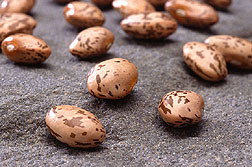|

Pinto beans like the these
could benefit from a new germplasm line that has resistance to anthracnose
disease. Click the image for more information about it.
|
New Pinto Bean Now Resists Anthracnose
Disease By Jan
Suszkiw
October 27, 2004
A new pinto bean germplasm line resistant to anthracnose is now
available for use in developing new varieties of the legume crop.
Germplasm line USPT-ANT-1 harbors a single gene, Co-42,
which confers resistance to the most-destructive races of Colletotrichum
lindemuthianum, the fungus that causes anthracnose, notes Phil Miklas. A
plant geneticist at the Agricultural
Research Service
Vegetable
and Forage Crops Production Research Unit, Prosser, Wash., he is handling
seed requests.
In dry edible beans, athracnose causes disease symptoms that
include unsightly cankers on the plant stem, pods and seeds. Endemic to
Michigan, New York and other Great Lakes states, anthracnose most recently
emerged as a threat to 350,000 acres of susceptible pintos grown in Minnesota
and North Dakota. Those two states, plus Michigan, produce about half the
nation's $629 million dry edible bean crop.
Commercial pinto beans derived from the new germplasm line would
be the first to resist anthracnose, according to Miklas. Chemical fungicides,
clean-seed programs and sanitation are the standard control measures. But crop
resistance is the keystone defense. To develop USPT-ANT-1, Miklas used
marker-assisted selection, a gene-detecting technique that saves the time
involved in infecting plants and then waiting to visually check them for
resistance traits. USPT-ANT-1 is the product of crosses, and brackcrosses (used
to eliminate undesirable traits), made among established pinto bean cultivars,
including Othello, Maverick and Buster, with SEL 1308 providing the
Co-42 gene.
In field trials, USPT-ANT-1 produced seed yields that were 107
and 90 percent of Othello at test sites in Prosser and Idaho, respectively.
USPT-ANT-1 also compared favorably to Buster, another commercial check variety.
In those tests, the germplasm line reached its peak growth, or maturity, nine
to 14 days later than Othello and four days later than Buster.
Jim Kelly, at Michigan State
University; Shree Singh, at the
University of Idaho; and Ken
Grafton, at North Dakota State
University, collaborated with Miklas on the pinto's development, testing
and evaluation.
ARS is the U.S. Department of
Agriculture's chief scientific research agency. |